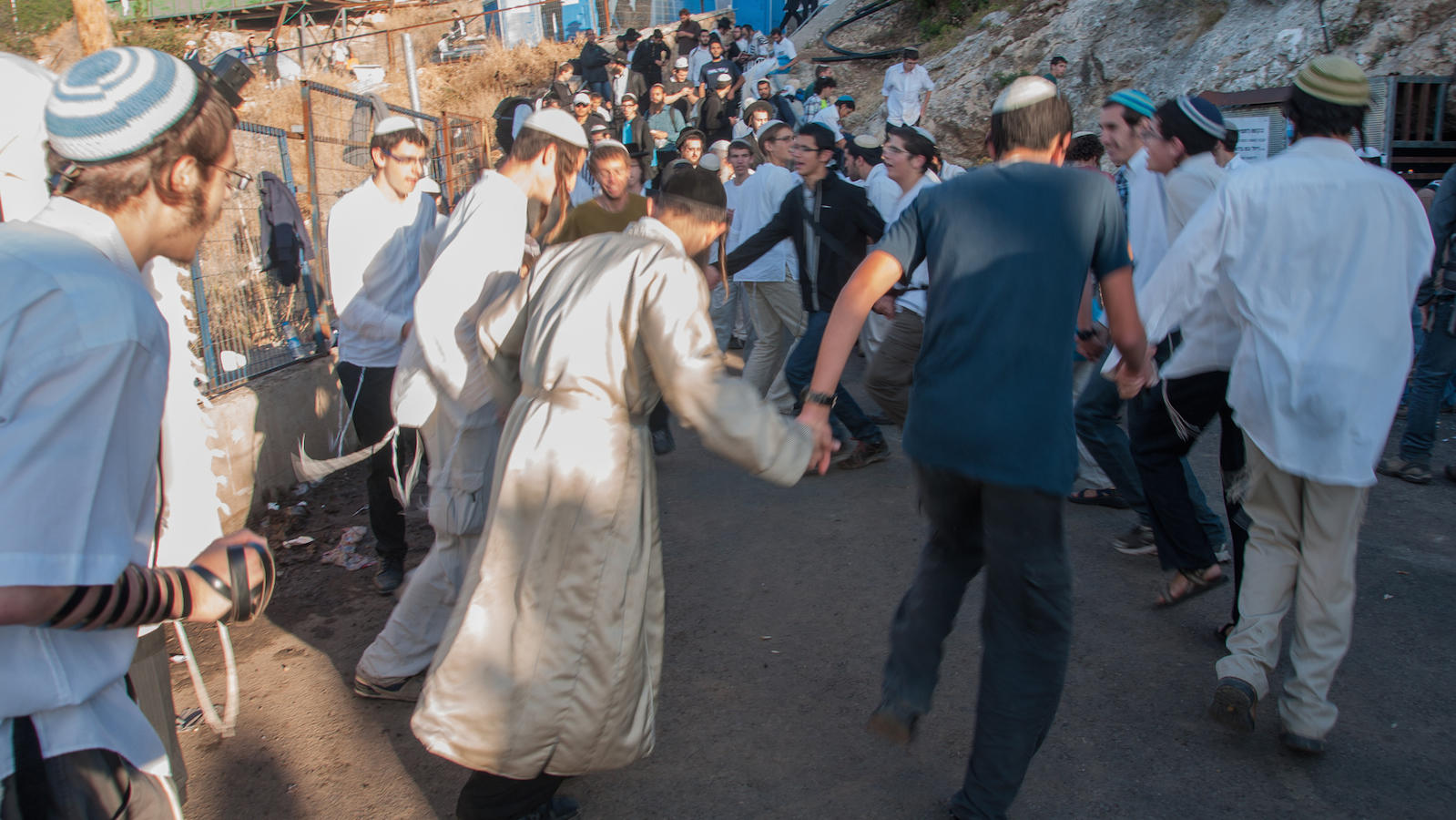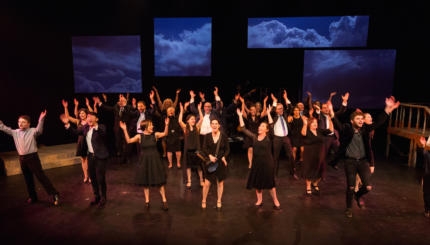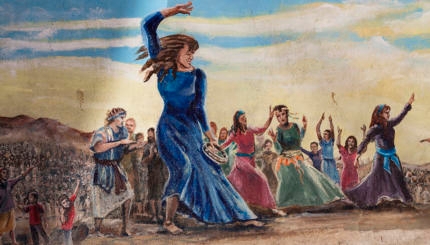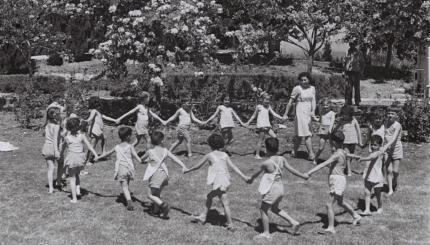In the Bible, Mishnah, and Talmud, dance is referred to in various contexts as an important ritualized activity and as an expression of joy.
Victory Dances
Biblical dancing to the accompaniment of drums is associated with the celebrations of military victories and welcoming home heroes who have routed an enemy. The women’s role was to receive and extol the fighters.
After the triumphant crossing of the Red Sea, “Miriam, the prophetess, the sister of Aaron, took a timbrel in her hand; and all the women went out after her with timbrels and with dances” (Exodus 15:20-21). On his triumphant return from battle to Mizpah, Jephtah was greeted by his daughter with timbrels and dancing (Judges 11:34).
When David and Saul returned from the battle with the Philistines, “the women came out of all the cities of Israel, singing and dancing, to meet King Saul, with timbrels, with joy, and with rattles” (Samuel I 18:6).
There is a detailed description of a victory parade, where Judith leads the women in the dance, to the accompaniment of a special thanksgiving song: “And all the women of Israel hurried to see her, and they praised her and made a dance for her…And she went out in the dance before all the people, leading all the women” (Judith 15:12-13).
Ecstatic Dances
The most telling biblical evidence of the power of music inspiring ecstasy and the prophetic vision is connected with King Saul. A passage from Samuel tells that Saul goes to the hill of God where he meets a group prophesizing while in motion, accompanied by several instruments.
The text adds: “And the spirit of the Lord will come mightily upon thee, and thou shalt prophecy with them, and shalt be turned into another man” (Samuel I 10:5-6). There is no mention of dancing, which typically accompanies ecstatic practices, but the movement that is an inherent part of the situation described may well allude to its ritual nature.
David’s dance before the Ark was an example of the religious ecstatic dances performed by men. The Psalms exhorted people to “praise God’s name in the dance”–“praise Him with timbrels and dance” (Psalms 149:3; 150:4).
Folk Dances
Detailed descriptions have been handed down to us from the period of the Mishnah, from which we learn that there was folk dancing at religious celebrations. During the festival of Tabernacles, there was a daily procession around the altar in the Temple following the sacrifices.
The celebrations reached a climax in the dances of the water-drawing festival: “Whoever has not witnessed the joy of the festival of the water-drawing has seen no joy in life. Pious men and men of affairs danced with torches in their hands, singing songs of joy and of praise, and the Levites made music with lyre and harp and cymbals and trumpets and countless other instruments” (Sukkah 5:1b).
The Book of Judges (21:21), in describing the annual feast in Shiloh, tells of the bride-choosing ceremonies. The story of the capture of brides by the surviving men of the tribe of Benjamin indicates that choosing brides during the vineyard dances was a recognized practice in Israel.
Others believe it was the celebration of the vines on the Fifteenth of Av. According to the Mishnah, Rabbi Simeon ben Gamliel declared, “There were no holidays for Israel like the fifteenth of Av and the Day of Atonement, on which the daughters of Jerusalem went out in white dresses which were borrowed so that no one need be ashamed if she had none. And the daughters of Jerusalem went forth and danced in a circle in the vineyards. And what spake they? ‘Youth, lift up thine eyes and behold her whom thou wouldst choose'” (Taanit 4:8).
In the Song of Songs (7:1), one finds the rather obscure mention of “the dance of the two companies,” which seems to have been taken from a traditional wedding dance, and may imply two groups of dancers, a type of dancing that can still be seen at Bedouin festivities in the Middle East.
In talmudic literature (Ketubot 17a) the bridal procession was regarded with great deference and was given priority on public thoroughfares requiring even a funeral procession to make way. Dancing in honor of the bride at a wedding was considered an act of religious devotion. Rabbis and scholars performed it joyously, each in his own manner.
Rabbi Judah ben Ilai would take a myrtle twig and dance before the bride singing. Rabbi Samuel ben Isaac, even when he was old, would juggle three myrtle twigs as he sang and danced. Rabbi Aha danced with the bride on his shoulder (ibid.).
In the Diaspora
During the dispersion, the dancing associated with the normal activities of a nation in its own country ceased. The rabbinical authorities often forbade dancing in public.
The many discussions in the rabbinical literature and responsa about dancing include opinions ranging from lukewarm compromise to outright hostility. At weddings and bridal feasts and for the Sabbath and particularly on Purim and Simhat Torah and Lag ba-Omer dancing continued while taking on new forms.
In European Jewry of the Middle Ages, dancing for pleasure was an end in itself. In the medieval ghettos of France, Germany, and Poland, where living quarters were crowded, almost every Jewish community had a wedding-house or Tanzhaus for festive occasions. Here the Tanzfuehrer (dance leader or caller) was aided by hired musicians.
During the Renaissance, Jews danced for recreation and entertainment. David Reuveni describes the dancing in the home of Jehiel Nissim of Pisa in 1524. They also danced in public as in the procession of Palermo celebrating the marriage of King Ferdinand of Castille and Isabella of Aragon in 1469.
In Jewish homes in Italy the Hebrew teacher taught Bible and Talmud, music, and dancing. That Jews engaged extensively in the profession of teaching in that period is emphasized by the recurring laws closing schools of dance and music conducted by Jews, such as the edicts of 1443 in Venice, and 1466 in Parma.
There were Jewish dancing teachers in Renaissance Italy, the most distinguished dance master of the time being Guglielmo de Pesaro, author of a treatise on the dance dated 1463. In the 16th century, another Jew, Jacchino Massarano, won fame as a dance master and teacher in Rome.
Oriental Jewry
There are many communities, such as the Moroccans, Georgians, Libyans, and Ethiopians, in which spontaneous group folk dancing is important, yet the Jews of Yemen and Kurdistan Jewry are among the most prominent traditional cultures attributing dynamic importance to dance in the daily and festive life of the community.
Dance among the Jews born in Yemen comprises stylistic diversity characteristic of urban and rural settlements as well as including women and men. Dancing usually takes place during ceremonies and celebrations.
Fundamentally, the men’s dances are composed of steps and figures executed in a very small area. The dominant line is vertical–with agile, springy bending of the knees. The very expressive hands are used for an infinite variety of gestures. One or two singers, rhythm instruments, or hand clapping always accompany the dance, but no melodic instruments are used.
The women’s dances are less variegated and more restrained. They are accompanied by the singing of the dancers themselves, or that of two female musicians who beat the rhythm respectively on copper plate and drum.
Hasidic Dances
With the rise of Hasidism in Eastern Europe in the 18th century, dance assumed great importance for the Jewish masses. Israel ben Eliezer Ba’al Shem Tov, the founder of Hasidism, used dance to attain religious enthusiasm (hitlahavut) and devoted adherence to the Almighty (devekut). He taught his followers that “the dances of the Jew before his Creator are prayers,” and quoted the Psalmist, “All my bones shall say: Lord, who is like unto Thee?” (Psalms 35:10).
Hasidic dance assumed the form of the circle, symbolic of the Hasidic philosophy that “every one is equal, each one being a link in the chain, the circle having no front or rear, no beginning or ending.” The Hasidim would start their dancing in slow tempo, and as the music became faster they held arms upwards and leapt in the air in an effort to reach spiritual ecstasy. The accompanying melodies were composed to brief texts from either the Bible or the Talmud.
Nahman of Bratzlav, great-grandson of the Ba’al Shem Tov, believed that to dance in prayer was a sacred command, and he composed a prayer which he recited before dancing. He and other Hasidic rabbis called for dancing on all festive occasions and even on the solemn days of the Ninth of Av, Rosh Hashanah, and the Day of Atonement.
During the celebrations on Simhat Torah, the usual processions with the scrolls reached a climax in the rabbi’s own dance. Wrapped in a prayer shawl, with a scroll held high in his hands, the rabbi danced with spiritual ecstasy as the Hasidim sang and clapped hands in a circle around him.
The Hasidim danced on Friday nights around the rabbi’s banquet table, and at twilight on Saturday they danced with mystical fervor. Hasidic dancing has influenced the celebrations at Jewish festivals generally, and has served as the basis and inspiration of choreography on Jewish themes in ballet.
Reprinted with permission from the Encyclopedia Judaica (Thomson Gale).
Av
Pronounced: ahv, Origin: Hebrew, Jewish month usually coinciding with July-August.
Hasidic
Pronounced: khah-SID-ik, Origin: Hebrew, a stream within ultra-Orthodox Judaism that grew out of an 18th-century mystical revival movement.
Purim
Pronounced: PUR-im, the Feast of Lots, Origin: Hebrew, a joyous holiday that recounts the saving of the Jews from a threatened massacre during the Persian period.
Torah
Pronunced: TORE-uh, Origin: Hebrew, the Five Books of Moses.



